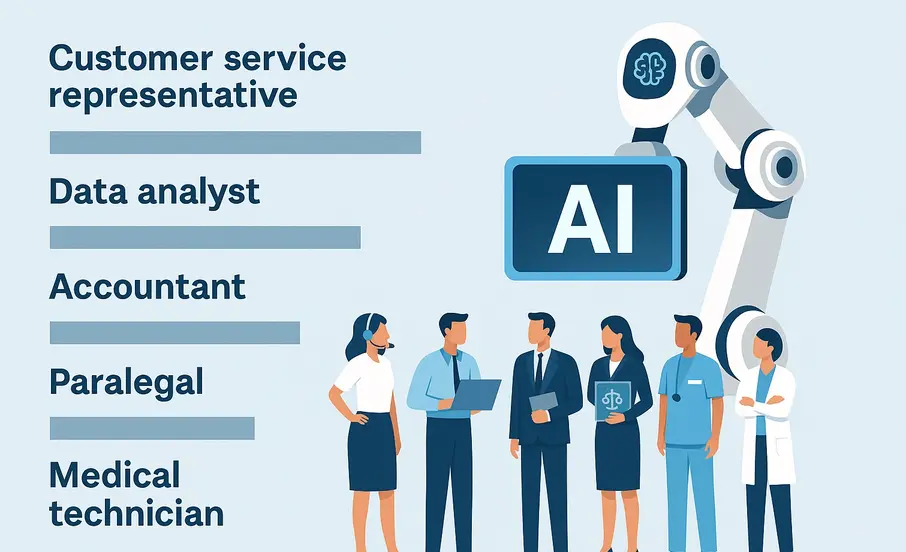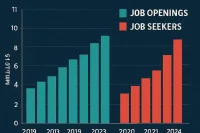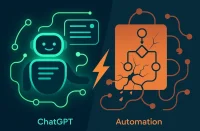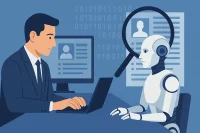These jobs are most likely to change with AI according to federal data analysis that reveals three specific fields facing potential workforce reductions due to artificial intelligence implementation. The rapidly evolving technology is already impacting the job market in significant ways, with insurance adjusting, credit analysis, and paralegal work identified as the most vulnerable sectors. However, the analysis also points to growth opportunities in software development, personal finance, and engineering fields.
The current job market presents significant challenges for recent college graduates, with many finding themselves “up a creek” when seeking employment in traditional fields. This reality is driving a fundamental shift in how workers must approach their careers, with AI proficiency becoming essential for competitiveness across virtually all industries.
The transformation is happening at an unprecedented pace, requiring workers to adapt quickly or risk being left behind. Understanding which jobs are most vulnerable to AI disruption and which offer the best growth opportunities is crucial for career planning and skill development.
The Three Most Vulnerable Fields: Where AI is Making the Biggest Impact
Insurance adjusting leads the list, where AI systems can process claims and assess damage more efficiently than human adjusters. The automation of routine assessment tasks and data processing makes this field particularly susceptible to AI disruption.
Credit analysis represents another highly vulnerable field, as AI systems can analyze financial data, assess creditworthiness, and make lending decisions faster and more consistently than human analysts. The ability to process vast amounts of financial information quickly makes this an ideal application for AI technology.
Paralegal work is the third field facing significant disruption, as AI can assist with document review, legal research, and case preparation more efficiently than traditional methods. The routine nature of many paralegal tasks makes them prime candidates for automation.
The Growth Sectors: Where AI Creates New Opportunities
Software development leads the growth sectors, where AI tools are creating new opportunities for developers to work more efficiently and tackle more complex problems. The demand for software engineers continues to grow as AI implementation requires skilled professionals to develop and maintain these systems.
Personal finance represents another growth area, as AI tools can help financial advisors provide better service to clients while handling routine tasks more efficiently. The combination of human expertise and AI assistance creates new value propositions in this field.
Engineering fields, particularly those involving AI integration and automation, are experiencing significant growth as companies seek professionals who can design and implement AI-driven solutions across various industries.
The Engineering Advantage: A Case Study in AI Adaptation
The success story of Lucas Schreiber, a recent engineering graduate from the University of Saint Thomas who secured full-time employment despite the challenging job market, demonstrates effective adaptation. His success demonstrates how embracing AI can create opportunities rather than threats.
Schreiber’s approach of using AI as a tool to increase effectiveness rather than viewing it as a threat has positioned him well in the current market. His willingness to adapt and learn new technologies has made him more valuable to employers rather than less.
The engineering field’s growth potential lies in its ability to integrate AI tools into existing processes while maintaining the human judgment and creativity that remains essential for complex problem-solving and innovation.
The Job Market Reality: Challenges for Recent Graduates
This transformation is creating a difficult environment for recent college graduates entering the workforce. The traditional pathways to employment are being disrupted, requiring new approaches to career development and skill acquisition.
The current job market’s challenges are particularly acute for those who haven’t developed AI-related skills or who are entering fields that are most vulnerable to automation. This reality is forcing a fundamental rethink of how young people prepare for their careers.
The solution lies not in avoiding AI but in learning to work with it effectively. As Professor Abraham notes, AI is a tool that increases effectiveness so significantly that workers must know how to use it to remain competitive.
Helping Graduates Enter the AI Era
Recent graduates face a tough job market as traditional pathways give way to AI-driven change. Employers can support this new generation by hiring adaptable talent eager to learn, innovate, and grow in AI-enhanced roles. Post your job on WhatJobs today and connect with ambitious graduates ready to start their careers in the evolving world of work.
Post a Job Free for 30 Days →The Empathy Factor: Jobs That Remain Safe from AI
Jobs that require high levels of human empathy and interpersonal skills remain relatively safe from AI disruption. Counseling and healthcare positions are among the safest from AI disruption because they depend on human connection and emotional intelligence that AI cannot replicate.
These fields require complex human judgment, emotional support, and personalized care that goes beyond what AI systems can provide. The human element remains essential for building trust, understanding nuanced situations, and providing compassionate care.
The continued importance of these roles highlights the value of developing interpersonal skills and emotional intelligence alongside technical competencies in an AI-driven economy.
The Learning Imperative: Adapting to Stay Competitive
This trend requires workers to continuously learn and adapt their skills to remain relevant in a rapidly changing job market. The rapid pace of AI development means that skills that are valuable today may become obsolete tomorrow.
The key to success is developing a mindset of continuous learning and adaptability. Workers must be willing to embrace new technologies and approaches while maintaining their core expertise and human skills.
This learning imperative extends beyond technical skills to include understanding how to work effectively with AI systems and leverage their capabilities while maintaining human judgment and creativity.
The Tool vs. Threat Paradigm: Reframing AI’s Role
This transformation can be approached as either a threat or an opportunity, depending on how workers choose to engage with the technology. Those who view AI as a tool for increasing effectiveness are more likely to succeed than those who see it as a threat to their job security.
The successful approach involves learning to use AI to enhance human capabilities rather than compete with them. This means developing skills in AI oversight, prompt engineering, and result interpretation while maintaining critical thinking and decision-making abilities.
The goal is to become someone who can work effectively with AI systems rather than someone who is replaced by them. This requires a fundamental shift in how workers approach their careers and skill development.
The Future of Work: Preparing for Continuous Change
This represents just the beginning of a long-term transformation of the job market that will require ongoing adaptation. Workers must prepare for a future where change is constant and adaptability is essential for career success.
This preparation involves developing both technical and human skills, learning to work with AI systems, and maintaining the ability to think critically and creatively in an increasingly automated world.
The workers who thrive in this environment will be those who can effectively bridge the gap between human and artificial intelligence while maintaining the unique value that human workers bring to their roles.
The Competitive Advantage: AI Proficiency as a Career Asset
AI proficiency is becoming a competitive advantage rather than just a nice-to-have skill across all industries. Workers who can effectively use AI tools are more valuable to employers than those who cannot.
This competitive advantage extends across all industries and job levels, from entry-level positions to senior management roles. The ability to work with AI is becoming as important as traditional technical or professional skills.
The investment in learning AI tools and developing AI-related skills pays dividends in terms of career advancement, job security, and earning potential. Workers who embrace this reality are positioning themselves for success in an AI-driven economy.
The Path Forward: Embracing Change While Maintaining Humanity
Workers must embrace technological change while maintaining the human skills that make them unique and valuable. This balance is essential for long-term career success.
The future belongs to workers who can effectively combine human judgment and creativity with AI efficiency and processing power. This hybrid approach creates the most value for employers and provides the best job security for workers.
The key is to view AI as a partner in productivity rather than a competitor for jobs. This mindset shift is essential for thriving in an AI-driven economy.
Frequently Asked Questions
What are these jobs most likely to change with AI?
These jobs most likely to change with AI include insurance adjusting, credit analysis, and paralegal work, which are facing potential cuts, while software development, personal finance, and engineering offer growth opportunities.
How does these jobs most likely to change with AI affect recent graduates?
These jobs most likely to change with AI creates significant challenges for recent graduates entering the workforce, requiring them to develop AI skills and adapt to changing job market conditions to remain competitive.
What are the safest jobs from these jobs most likely to change with AI?
The safest jobs from these jobs most likely to change with AI are those requiring high levels of human empathy and interpersonal skills, such as counseling and healthcare, where human connection remains essential.
How can workers prepare for these jobs most likely to change with AI?
Workers can prepare by learning to use AI tools effectively, developing both technical and human skills, embracing continuous learning, and viewing AI as a tool for increasing effectiveness rather than a threat to job security.
A Real-World Example: Sarah’s Career Transformation
Sarah Martinez, a 28-year-old paralegal from Minneapolis, exemplifies how these jobs most likely to change with AI can force career adaptation. After seeing her field identified as vulnerable to AI disruption, Sarah decided to proactively develop new skills rather than wait to be displaced.
“I realized that these jobs most likely to change with AI meant I needed to adapt or risk being left behind,” Sarah explains. “Instead of fearing AI, I decided to learn how to work with it to make myself more valuable.”
Sarah’s approach involved learning AI tools for legal research and document analysis while developing skills in legal technology consulting. She positioned herself as someone who could help law firms implement AI solutions rather than someone who would be replaced by them.
“These jobs most likely to change with AI taught me that the key is finding where human judgment adds value to AI capabilities,” Sarah says. “I now work alongside AI tools to provide better service to clients while maintaining the human touch that’s essential in legal work.”
Within two years, Sarah had transitioned from a traditional paralegal role to a legal technology consultant position, earning 40% more while working with AI tools rather than being replaced by them. Her experience demonstrates that proactive adaptation to AI can create new opportunities rather than just preserving existing ones.




